There are two approaches to psychology – behavioral and cognitive. Cognitive psychology is a newer branch than behavioral, but it has grown in stature and popularity.
In a nutshell, cognitive psychology is the study of how people think – their mental processes, how they process and remember information, and store/recall the information that they have absorbed. Most interesting is the research that speaks to short and long-term memory.

Short-term memory lasts for about 20-30 seconds, and an observer can usually hold maybe five to nine items for those seconds. Transferring that information to long-term memory is another brain process, but long-term memory is more enduring and durable.
And here’s the other thing about long-term memory. It results in cognitive biases. As people “send” experiences to their long-term memories, they accumulate and, when those people are confronted with a new experience, their thinking (and behaviors) are “colored” by all of those prior experiences. These are known as cognitive biases. And they result in shortcuts that the brain takes to those cumulative memories that have been stored over time. The person impacted by those cultural biases does not even realize they have taken over.

How Cognitive Biases Can Be Used in Email Marketing
Marketers who study cognitive psychology have an edge on their peers as they create their content, and this, of course, relates to any email marketing they engage in.
Here are cognitive biases that can be used and how to use them:
1. Aversion to Loss
We’ve all experienced it many times in our lives. We’ve lost out on a great sale; we lost a coupon for a great discount; we’ve lost a contest or a competition. And we’ve lost more important things too – maybe a relationship, a pet, etc. Each of these losses gave us negative feelings that have been imprinted in our memories, and we want to avoid those if possible.

Without realizing it, the aversion to loss can cause us to pursue things that we may not even have had an interest in until now. All of a sudden, we pursue them when presented, because we don’t want to lose out.
You can use this fear of loss to advantage in your email marketing. Subject lines can convey an opportunity that should not be missed – super savings for the next 24 hours, for example. Experiment with subject lines of this type and track the opens and, of course, the responses.
2. In-Group Bias – Tribalism
Have you ever attended a social function to which you have been invited and arrived horribly under-dressed or horribly over-dressed? Usually, this is because you are unfamiliar with the group of people who are in attendance. It’s a very uncomfortable feeling.
We are all most comfortable when we are in the company of those who are “like” us. We have friends with the same values, the same language nuances, the same manner of dress and behavior, the same social life, etc.
And we feel uncomfortable when we are cast into a group with which we are unfamiliar. Not only do we feel “out of place,” but we may be bored, intimidated, suspicious, or worse. It’s a cognitive bias, this feeling that we can only relate to and be comfortable with those like us.

The smart email marketer will get this. S/he will have researched the target audience, of course, and dug deep into that audience’s lifestyle preferences, language, values, belief systems, and more. That information should drive everything that an email marketing campaign includes.
For example, millennials and Gen Zer’s put great emphasis on doing business with companies that they see as authentic, that exhibit social responsibility, and that put relationships with their customers over sales.
Email marketing must honor these values. Instead of only sending emails that focus on products or services, discounts, sales, etc., send out messages that make you “one of them.”
- focus on a charitable event in which your business participated or supported;
- speak to how your business, either in its product production or in its activities, is supporting environmental sustainability;
- tell your story, stories of your staff members, stories of your customers;
- put a face on you and your company;
- use humor and inspiration for no other reason than that it entertains or uplifts
And as you craft these email messages, be certain that you are using language that “connects.”
If you struggle with “language” and the right hooks in subject lines, then get some help. There is a number of freelance copywriters and departments of writing agencies, such as Trust My Paper, that have the expertise to create content for both subject lines and email content that connects with a specific audience and their cognitive biases.
3. Status Quo Mentality – The Familiar is Comfortable

How many of us are steeped in the thinking with which we grew up? We might use the same laundry detergent or cooking recipes that our mothers used; we might use the same lawn care products our fathers used. We might have shopping routines that have developed over a long time. All of these are stored in our long-term memories and adhering to these products and routines is comfortable. We don’t want to change.
No matter how flexible and adaptable we like to see ourselves, there is comfort in the familiar and the status quo. Our cognitive biases in this regard are built upon years of “conditioning” and long-term memories.
From a marketing standpoint, this can be difficult. We are often asking our target audience to make a change – to buy a new product or service and thus make a change.
Your emails should not be couched in CTA’s that are “forcing” a change on your audience. Make any conversion you want your recipients to make easy and seamless. And never ask for more than one conversion in a single email – you will discourage and overwhelm them, and they will not make any decision at all.
4. Anchors are Powerful
When we consider purchasing a new product, we tend to compare it with similar products or services we have purchased in the past. Consider a vacation, for example. The last vacation you took, you paid $100 a night for a pretty good hotel room. Now, you are being asked to pay $175/night for a comparable one. Your “anchor” is $100, and you are not happy about the higher price.
The same is true when you present products or services, along with pricing, in an email. You should anticipate that your recipients will be biased, based upon their past memories of the quality and/or prices they paid. When you do anticipate these, you can “head them off” in advance and gain control of their anchoring tendencies.

You can provide a different anchor. Compare your product or service to those that are offered by your competitors. If your price is higher, show the better value of the product that justifies your price. If your price is lower, show that the quality is the same as the higher-priced one.
Another tip: If you offer several similar products with different pricing, show the most expensive one first. This will become the “anchor.” As the lower priced ones are subsequently shown, readers will believe they are getting a bargain as they view the cheaper versions.
5. Reciprocity
Marketers understand the power of this psychological strategy.
Most of us have grown up experiencing reciprocity. Someone does something nice for us and we return that behavior by giving back in some way. It’s imprinted in our long-term memory and does guide our behavior. We are somewhat “programmed” to feel an obligation to do this.

Using it in email marketing is easy.
- Decide on the conversion you want from your content
- Look at options for providing something free up front – this is what will go in your subject line.
- Deliver what you promise (the freebie) and then ask for the conversion – subscribe to your newsletter? Make a purchase? But do not make the freebie contingent on the conversion. This is important. The freebie should come with no strings attached. This increases the sense of obligation the recipient has.
6. The Bandwagon Effect
Again, this is a well-known psychological tactic – the “everybody’s doing it” effect.
In marketing, this is often known as social proof. And emails are a great way to provide it, without focusing on a direct sale.
This is where storytelling can come into play. While telling stories is great for a blog and social media marketing, marketers often fail to realize that stories in emails can be just as captivating.
Here is how this works. You solicit photos and even videos of customers using your product or service. And, yes, you may post them on your social media pages, on your website, and even in your blog. But you may not have thought about the power they can have in your email messaging too.

When you accumulate those photos, videos, etc., devise emails that tell those stories. Your subject lines can be something like, “Jan has a great story to tell.” This intrigues the recipient, and they are more likely to click through because it does not look like just a hard sell. Jan’s story could be interesting.
And once Jan’s story is told/shown, your recipient is more inclined to get on that bandwagon of happy customers. This type of email answers typical questions that consumers have – Will this work for me? Has it worked for others just like me?
It also answers the need that consumers have to take advantage of a good thing since so many others are.
7. The Use of Fear
Fear is definitely a negative emotion. But every person on earth has experienced it, and those incidents are embedded in their long-term memories. As children, we feared the dark, strangers, even getting lost. As we matured into adulthood, we began to fear other things – loss of job or income; loss of a relationship; etc. And many of us have experienced those types of losses, which are now embedded in our long-term memories.
While fear is certainly a negative emotion, it can be used (but sparingly) in marketing. And it is often best used through storytelling.

If you are a real estate agent and trying to get listings, you have probably developed an email list of prospective buyers and sellers. What are the common fears of these two groups? For sellers, it may be staging their properties in the wrong way for lookers. For buyers, it may be missing out on a great property by not getting pre-qualified for a loan. These fears can be woven into stories of sellers and buyers who did just that and, as a result, lost a sale or a purchase.
If you sell life insurance, you can use stories about people who did not have policies in place that protected their loved ones, and the consequences for those loved ones after death.
If you sell a product that improves or eases lawn and garden care, then you can show the effects of neglecting lawns and gardens; you may sell a product that keeps unwanted pests from invading a home, and you can relate stories (with visuals of course) of the effects of ant/roach/moth/termite infestations.

Email subject lines such as “don’t let this happen to you” or “John is sorry he ignored the warnings” can work well.
In the End…
We all have our pre-programmed thinking, based on our experiences and our long-term memories Our brain has stored these memories, and they do impact our thinking and our behaviors in the present.
As marketers, we can use this cognitive psychology to engage and capture the attention of our audiences and move them to take action.
Email is a great way to use cognitive psychology in marketing efforts. Subject lines can play into these seven types of thinking, and the content of those emails can move audiences to taking action based upon that thinking. It takes a solid understanding of what engages and compels, and psychology has an important role to play. Use it.
Conclusions
These are the most common cognitive biases, that often work against you. But now you know what they are and how to turn them to working for you and help you in your marketing business strategies.
If you’re interested in learning about more cognitive biases, you check the list here.
About the Author

Melanie Sovann, born in 1990 in the greater LA area, is a seasoned writer and blogger, passionate about a broad spectrum of topics, ranging from technology to sociology. She is an avid contributor at 3to5marketing.com, blog that has amassed a sizable following over the years.






Nurturing leads and guiding prospects through the sales conversion funnel is the future of marketing and getting widely adopted by marketers all over the world. Our focus should be on the personalized journey of prospects until the conversion stage and have minimum human intervention by automating repetitive tasks like lead generation, social media engagement, and other manual tasks.